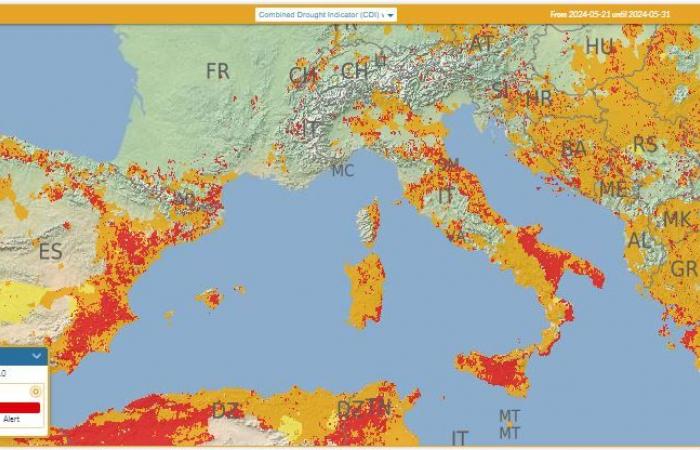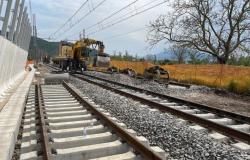“What is happening in Sicily, but which is progressively moving from the South to Central Italy, has worse characteristics than the previous great droughts in the North, but is receiving less attention from public opinion: it has never happened before that animals had to be slaughtered to the impossibility of feeding and quenching their thirst! Unfortunately we are becoming accustomed to the culture of disaster”: the alarm in the words of the President of the National Association of Land and Irrigation Water Management and Protection Consortia is dramatic, Francis Vincenziin front of the data released by the ANBI Observatory on Water Resources.
“According to what was published by the Basin Authority of the Sicily hydrographic district on 27 May, of the 288.95 million cubic meters then retained by the 29 dams of the island, the water actually available in the basins (from the capacity already reduced by the neglect of the large presence of sediment on the seabed) was just over half (154.23 million cubic metres), having to subtract, for example, the volumes intended for the survival of the ichthyofauna, those for the safety of the reservoir and those intended for a accelerated evaporation; in detail, in 11 of the 29 large Sicilian reservoirs, the usable volume fluctuated between 0 and 1 million cubic meters, while in another five it was between 1 and 2 million“, reports the ANBI Observatory on Water Resources.
“Considering that there has been no significant rainfall in Sicily since May 27th – he adds Maximum GarganoGeneral Director of ANBI – it is presumable that the water remaining in more than half of the island’s basins is effectively unusable. Net of the responsibilities of politics, incapable of responding adequately to the progress of the climate crisis, the scenario, supported by the European Drought Observatory (EDO), is of a red alert for the great aridity, precursor of desertification, on over 50% of the territories in Sicily, Puglia and Basilicata, to which add the coastal areas of Calabria and Sardinia, as well as areas located along the Apennine ridge and the Adriatic strip”.
Emblematic, reports ANBI, “it is the condition of Pozzillo lake, in the province of Enna: on 23 July of the very dry 2021 it contained around 6 million cubic meters of water (see attached photo); as of May 27, 2024 (therefore almost two months earlier), only millions remained in the Pozzillo basin. mc. 5.69 and of these only 690,000 cubic meters were available to users. With temperatures steadily above 30° and reaching 40°, with no rain on the horizon and even without withdrawing anything, it is dramatic to imagine what that reservoir will become at the end of July with overwhelming impacts on the local economy. The condition of groundwater is no longer rosy, especially in the Sicily eastern: on the slopes ofEtna the lowering of the water table is estimated at 20 meters (source: SIDRA); in the Catania area, equally significant drops are also recorded in the Calatino area. The Fiumefreddo aquifer, on which the water supply of 70% of the city of Messina depends, has dropped by at least 15 meters and the level has come dangerously close to the level below which it can no longer be withdrawn (source: AMAM) . The situation is so serious that the minutes of the Basin Authority show that the agenda also includes the resumption of water withdrawals from wells contaminated by nitrates, subject to purification of the water before its use. This may especially affect tourist areas, where over 10 million guests are expected in the high season”.
“The gravity of the water situation, which is emerging in central-southern Italy, will be the subject of the focus, which we will hold on Tuesday 25 June during the press conference in Rome for the presentation of the ANBI Assembly, scheduled for the beginning of July in the capital” informs again Vincenzi.
Said thisthe report ofANBI Observatory on Water Resources follows the situation of the most recent weeks: “With the exception of the Lario, the large lakes of northern Italy remain clearly above seasonal averages and the Maggiore even at the limit of capacity; the flow released overall together with Sebino and Benaco remains enormous: 1353 cubic meters per second, that is, sufficient alone to feed the Po river! In Valley of Aosta the flow of the Dora Baltea is decreasing, which however maintains a flow 52% higher than average; the water flow in the bed of the Lys torrent also decreases. In Piedmont, where the Baraggia reservoirs (Ravasanella, Ostola, Ingagna) retain 16.7 million cubic meters of water (a value much higher than the average for the period), river flows are decreasing, but remain in line with the monthly averages. In Lombardy, flow rates are still exceptional for the Adda river, in whose bed 429 cubic meters per second currently flow compared to an average of the recent five-year period of 266 m3/s. The regional water reserves, thanks to the full reservoirs and above all to the 1367.4 million meters cubes retained in the snow still present (+110% on average), are 38.3% higher than usual. In Veneto the snow melt together with the atmospheric instability of recent days are the reasons for the extraordinary flow values detected in the various river basins: Adige, mc/s approx. 665. (+88% on average); Brenta mc/s 132.55 (+53%); Bacchiglione, mc/s 40.85 (+54%). Among the rivers ofEmilia Romagna only Secchia, Panaro and Enza grow; decreasing, despite the abundant rainfall in May (+150% in the westernmost sectors) and demonstrating the increasingly markedly torrential character of the Apennine rivers, the flows of the Trebbia, Taro and Nure have fallen back below the average values of the period. On the plains and mountain basins of southern Romagna, a condition of rainfall deficit remains (-30% rainfall in May) and marked aridity (soil water content) in the first hills and in the plains (source: ARPAE). The scope of the Po river remains above average along the entire length of the river: in Pontelagoscuro, the Great River maintains a flow of over 2616 cubic meters per second (+45% on average). In Liguria on the other hand, the levels of the Entella, Magra, Vara and Argentina rivers drop noticeably; However, the water reserves retained by the Brugneto dam are comforting: around 25 million cubic metres, i.e. the maximum that can be filled. In Tuscany The flows of all rivers fall below average with the Arno at -35% and the Ombrone halved. However, the spring rains allowed a good accumulation of water reserves (+20%): the Bilancino reservoir is at 98% of the capable volume, Montedoglio retains 121 million cubic metres, while the cumulative volumes in the Levane and La Penna basins correspond at 88% capacity; the reservoirs in the Serchio basin are also 92% full and the Calcione reservoir in the Siena area is almost full“.
In Marche “the level of the Potenza, Esino and Tronto rivers is half a meter lower than in 2023 and together with the Nera they record lower hydrometric levels than the last five years. In Umbria the hydrometric height of Lake Trasimeno continues to reduce, which is now 15 centimeters below the minimum vital level; it is also cm. 25 lower than last year and scores well cm. 82 below the historical average. The rivers are not doing any better, as they are all well below average. The situation which is taking shape in the year is also serious Lazio, where the Tiber river is at just over 55% of the average flow rate for the period, the level of the Aniene continues to fall rapidly and the flow in the Velino is 27% lower than normal; only the Fiora resists with above-average flow rates. The lakes chapter is dramatic, with that of Albano, which in two weeks drops by a further 5 centimeters and seems destined for an unstoppable decline, as does Lake Nemi, which records a level almost half a meter lower in June 2023, counted among the driest of the new millennium in the region. In Abruzzo the hydrometric heights of the rivers Sangro in the L’Aquila area, Orta in the Pescara area and Vomano in the Teramo area are already in line with those recorded in the middle of August 2023 (!!) and the water reserves are at their lowest. In contrast, in Molise, is the condition in the Venafro Plain, where the spring rains allowed the irrigation season, which began just over a week ago, to be postponed; the result is that water availability is reassuring, thanks also to the compensation tanks, which have made it possible to overcome the small flow rates of the Volturno river, from which water is drawn for irrigation.
In Calabria the flow of the Coscile river is increasing (56.08 m3/s), while that of the Tacina in the Crotone area currently stands at 7.64 m3/s. In Basilicata the reservoirs now hold less than 300 million cubic meters of water, i.e. 40% of the total capacity; in one week they released over 9 million cubic meters and the deficit by 2023 has expanded by a further 17 million cubic meters, reaching -mln. mc.188 approx. In PugliaCompared to last year, less than half of the water reserves are available: around 1,400,000 cubic meters per day emerge from the reservoirs and it is foreseeable that the situation will worsen with the announced surge in temperatures“.
“The reclamation consortia are constantly engaged in making the irrigation network more efficient, but it is clear that an increasingly African climate will force an overall rethinking of the agricultural economy of one of the Italian food sources,” he concludes Massimo Gargano General Director of ANBI.
Continue reading on MeteoWeb






